What makes for the best livewell on any given fishing boat? There are a few critical features, some finer details, and plenty of “fails” to look for, including some weaknesses that aren’t necessarily visible upon first glance. And livewell quality counts big-time, especially if you’re one of those anglers on the Bay love to live line with spot. Even more so if you live line with peanut bunker, which are incredibly delicate in captivity. So, what should you look for as you choose the living quarters for your next batch of livies? Before we dig into the details, let’s make a list.
- Capacity
- Water flow
- Location
- Drainage System
- Interior shape
- Water containment
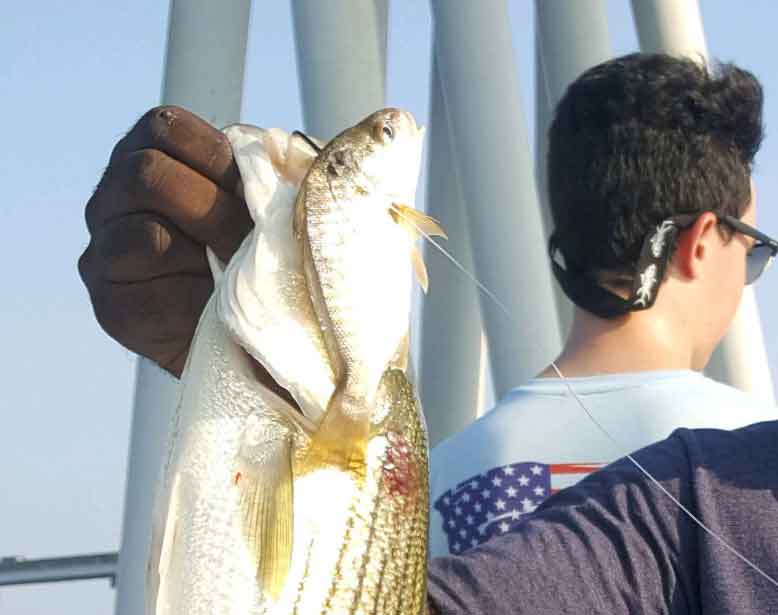
Livewell Capacity
Above all else, bigger is better. But that doesn’t tell the whole story. Many modern boats have multiple livewells and should be assessed by overall capacity, not by the capacity of a single livewell. Because while single large livewells do work well for keeping a single species of baits alive, many serious anglers want to keep different baits segregated to target different species of fish.
Just how much livewell capacity you need for the style of fishing you most enjoy varies by a number of factors. How many anglers do you normally have aboard? If you’re hauling a crew of six, you need the capacity to haul enough baits for everyone. What type of baits do you commonly use? You can pack in two or three spot per gallon of capacity but if you try that with bunker, the fish won’t live long. Do you fish from dawn to dusk, or are afternoon outings more your style? Short trips will require a lot less bait than full days. All of these factors need to be considered, so it’s impossible to say that every boat should have “X” gallons of livewell capacity. That said, as a rule of thumb plan on a minimum of a gallon of capacity per pound of live fish for the average species—if the livewell also checks off the below boxes.
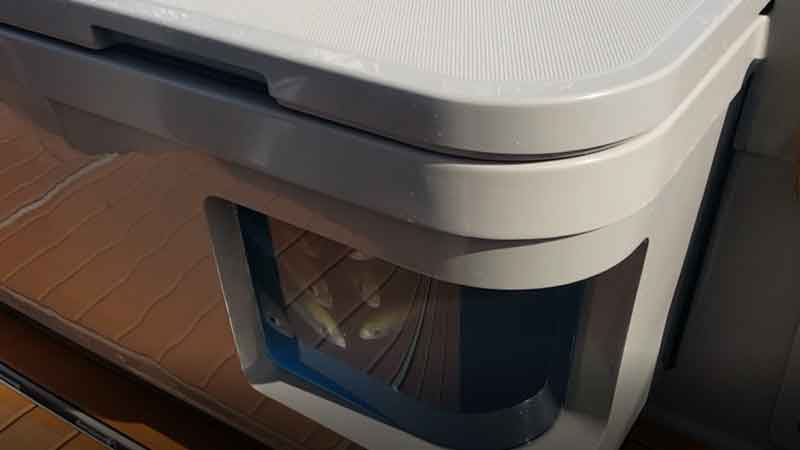
Livewell Water Flow
Insufficient water flow is another common issue with livewells, and unfortunately, can’t be judged at a glance—you need to check the pumps for their GPH ratings and turn them on to see just how much water is pumping. You’ll come across boats with 50-gallon livewells that are fed by rather wimpy pumps which can barely turn the water over, much less maintain a current that keeps the fish swimming comfortably in one direction.
Most pumps installed for livewells are repurposed bilge pumps. The larger the pump the more it costs, and since few people even bother to check pump size, many boatbuilders purchase and install ones which are simply not potent enough to do the job. And remember that you never get even close to 100-percent efficiency from a pump, thanks to bends in hoses, lifts above water level, and other factors. So as a general rule of thumb, look for pump capacities that are about 42 times the gallon capacity of the individual well. Why 42 times? Because that’s what the fish docs say; Dr. Daniel Benetti, director of aquaculture at the University of Miami, feels that this is sufficient for keeping most fish in good condition (and we’re not about to argue with him). As a point of reference, that means a fishboat with a 30-gallon livewell should have at least a pump rating of 1,260 GPH feeding it. Check under the hood, and you’ll see plenty of boats that have half that.
There are other variables that come into play regarding water flow, as well. The flow should create a current that’s strong enough to go beyond the length of the average bait’s body length every second, in order for the fish to maintain its position while swimming. Having water inlets at multiple heights is also important, because if the flow in a well isn’t properly designed “dead spots” can occur where layers or gyres of static water don’t get exchanged, and low-oxygen spots then form. Another potential water flow fail: pump-share arrangements, where you turn a valve to choose water flow from a pump to power either the livewell or a raw-water washdown. Not only does this a blatant cost-cutting measure on the builder’s part cause your pump to work overtime, it also reduces flow efficiency because of all the hoses going every which way.
Location in the Boat
Livewell location can have an impact on more than the fish, because it also can affect how your boat performs. A 30-gallon well located in the corner of the transom will add 240 pounds of weight very far off-center, having a noticeable effect when you’re up and running. Livewells are most commonly located in transoms, so having centered wells or ones on either side that counterbalance each other is much better than having a single off-center well. In the case of center console boats, you’ll also see livewells integrated under the forward console seat with some regularity. Since these are centered, the effect is usually negligible.
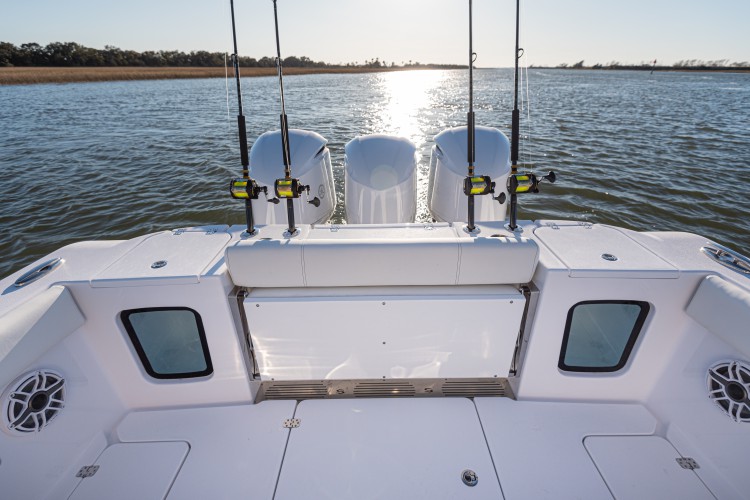
Livewell height matters, too. Even if a well is located along the centerline it will raise the boat’s center of gravity, impacting stability. That would seem to be an excellent argument for locating all livewells down low in the deck, but on the flip side of the coin, livewells located very low in the boat mean you have to bend and stoop every time you need to get out a bait.
There are a few other items to consider when it comes to livewell location and the convenience factor. If there’s a single well located aft in the boat, anyone fishing in the bow will have to walk back and forth whenever they need a new bait. If the livewell is in the back of a leaning post and under an aft-facing seat, you’ll probably have to ask someone to move every time you want to bait up. And if you see a rig that has one big well with several small ones in different areas of the boat, remember that this works out quite well when you have multiple people fishing in multiple locations (just keep the bulk of the baits in the big one, put a few in the satellite livewells, and refill them as necessary from time to time).
Livewell Drainage Systems
Overflow drains work best but they require more plumbing (and thus installation cost) than simply putting a drain in the bottom of the well and adding a stand-pipe. So, you unfortunately see lots of stand-pipes. Some can get jostled free by an aggressive use of the bait net or even by water sloshing around during a run, which can lead to a dry well full of dead baits. Stand-pipes also get in the way when you’re trying to scoop baits. If they break off or become damaged, your well becomes completely unusable. Worse yet, when you pull the pipe out there commonly isn’t a strainer or screen of some sort over the drain. Sooner or later, you can bet that one of your livies will get sucked down into the plumbing, and lodged in a hose. You might not notice the event when it takes place, but you certainly will smell it a few days later.
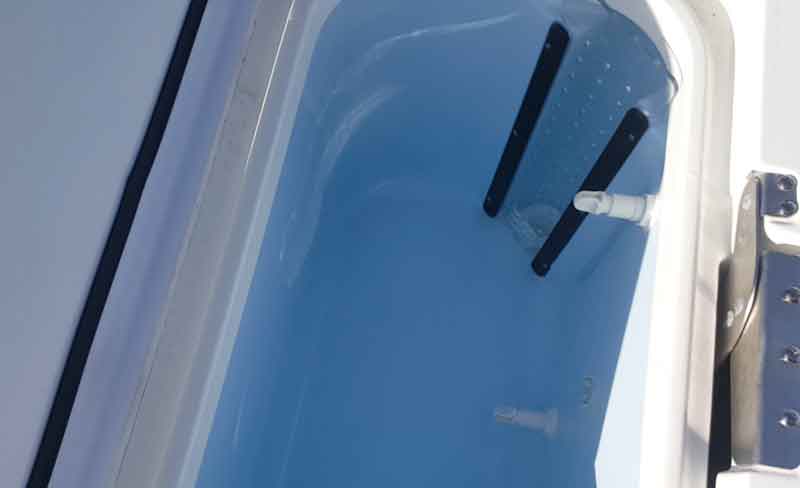
Livewell Shape
Most boatbuilders have caught on to the fact that sharp corners are bad because baits swim into them and beat themselves silly against the fiberglass, yet you’ll still see a few carelessly-designed examples of square or rectangular livewells now and again. Also be on the lookout for very narrow, deep livewells. These may boast a big capacity, but they accomplish it by providing lots of depth. You won’t be a fan when you realize you have to go elbow deep to scoop out your baits.
Water Containment
If you’ve ever been forced to sit near a livewell that didn’t seal properly, you know how uncomfortable it can be to get doused every time the boat rocks. And on some boats, the entire cockpit is subject to a briny bath from the baitwell, particularly when you're running and the seas kick up. But human comfort isn’t the only factor to consider. Sloshing also beats your baits to a pulp, and on a long offshore run, it isn’t unheard-of to open the livewell hatch on some boats and find out that half your baits are belly up.
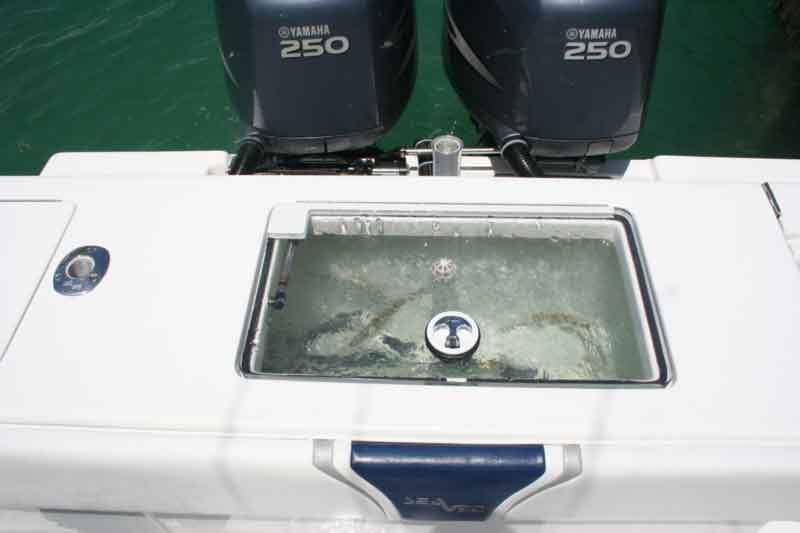
Hatches should be gasketed, and dog down tightly. Even better is a pressurized well. These are designed with a watertight seal at the top and they fill to the brim, minimize sloshing, and thereby minimize wear and tear on the baits as you run to the fishing grounds.
And The Best Livewell Is…
Are we being overly-picky, in our quest to find the best livewell? You bet. Truth be told, for the average angler who might try live lining a handful of times a year for no more than a few hours at a time, a fairly crappy well will probably work out just fine. And taking all of these little details into consideration, it may start to seem like designing the ultimate livewell is as complex as designing a space ship. But that’s because it is—in both cases you’re trying to keep living creatures alive in an environment that wants to kill them. To those baitfish, your boat is every bit as inhospitable as outer space would be to you and me. (And that’s before you skewer those little fish with an 8/0 Mustad). But if you want to have the very best livewell possible, all of these factors comes into play. So as you check out your next fishboat, play close attention to each and every one.